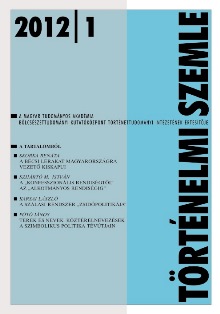Terek és nevek. Köztérelnevezések a szimbolikus politika tévútjain
Places and Names. The Naming of Public Places in the Wrong Ways of Symbolic Politics
Author(s): János PótóSubject(s): History
Published by: Magyar Tudományos Akadémia Bölcsészettudományi Kutatóközpont Történettudományi Intézet
Summary/Abstract: The lecture, which was held on 25 October 2011 in the Institute of History of the Hungarian Academy of Sciences, presents the legal background and the practice of the naming of public places at Budapest from the second half of the 19th century until now. The starting point is 1873, when, after the union of Pest, Buda and Óbuda, the standardization and Hungarization of names in a still predominantly German-speaking city now called Budapest was an urgent task. The aim of the street names was then merely to help the identification of places, an aim best served by individuality and stability of the names. The denomination of public places with personal names, and thus the adding to the functions of street names those of memory and propaganda, became ever more frequent from the turn of the 19th and 20th centuries. Alongside a growing number of monuments, the practice of street naming then also became part of symbolic politics. The spreading practice of naming public places after persons proved dangerous in the course of the 20th century from two aspects. One likely probability was that the relatives, friends and fellows of any great person, whether already dead or still alive, would like to see him immediately eternalised in a public space, possibly in the city centre and in a long wide street or a huge square. Another, related source of danger was that profound political changes would launch an avalanche of renaming public places, just as the demolition of public statues was an integral part of the shift from one political regime to another. The lecture follows the appearance of symbolic politics, the content of which may have differred in the successive periods, but the aim of which remained the same, from the first wave of renaming motivated by political propaganda (1914–1915) to the change of regime which took place in 1989–1990. The situation appeared near to consolidation in 1990, when, parallelly to the massive renaming process which was destined to efface the ideological traces of the socialist period, it was ordered that at least 25 years would have to pass after the death of any person before a public place could be named after him/her. This legal framework, which proved to be remarkably stable for two decades, was softened up by the municipality of Budapest in 2011, which lowered the duration of the moratorium from 25 to merely 5 years. The last part of the lecture analyses the recent great wave of renaming public places which took place in the spring of 2011, and points to the political motivations which emerge in the background. What we are dealing with is the setting up of the scenery for shifting the political regime, as if we were in fact living through the period of such a political shift. As if.
Journal: Történelmi Szemle
- Issue Year: 2012
- Issue No: 01
- Page Range: 161-173
- Page Count: 13
- Language: Hungarian

